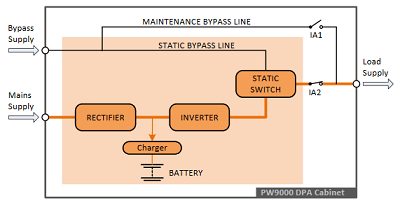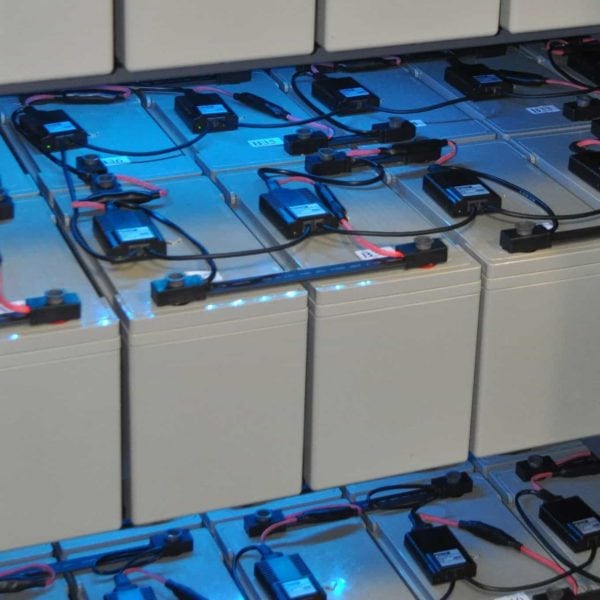Fully functioning batteries are essential to the operation of your UPS system. Once the UPS is installed, you should make sure you have an appropriate service, maintenance and replacement system in place so that your batteries are safe and ready for use in the event of a power outage.
In this article, we’ll cover the three most common UPS batteries in use today, the reasons why they might fail, and how you can make sure your batteries are maintained to optimise their lifespan and replaced in good time.
Types of UPS battery
The three main types of UPS battery are:
- VRLA
This lead-acid battery is the most common UPS battery. It is used in UPS systems because it is reliable, cost-effective and there is good infrastructure in place for recycling and disposal.
VRLA batteries are usually built up in a series of blocks, depending on the voltage required.
This can be internal, in dedicated ventilated battery cabinets or in open or cladded racks.
How long do VRLA batteries last?
The VRLA battery can have a design life of 5, 10, 12 or 15 years and they can operate at up to 80% of capacity at end of life.
- Lithium-ion
Lithium-ion batteries are becoming more popular for UPS specifications. They have a higher specific energy density, typically a longer design life and a shorter recharge time than VRLA.
These batteries are often lighter and take up less space than VRLA batteries, so are popular options for environments where space is at a premium.
How long do Lithium-ion batteries last?
These batteries have typical design lives of 15 to 20 years, with up to 70% capacity at end of life.
- Nickel-zinc
Nickel-zinc batteries are relatively new to the UPS space, and offer a range of benefits. The technology is claimed to be more sustainable than either VRLA or Lithium-ion, and they could take advantage of the existing recycling chains available for VRLA, making them more environmentally friendly all round.
How long do Nickel Zinc batteries last?
Nickel Zinc batteries are most suited to very short autonomies of around 5 minutes.
At present, Nickel-zinc batteries have a design life of 10 to 15 years. At 10 years, they’ll operate at 80% capacity, and with 70% capacity at 15 years at temperatures up to 35C
UPS battery monitoring and replacement
The varying characteristics of these batteries require different management and monitoring systems that affect the lifespan, reliability and safety.
With battery monitoring systems installed, the batteries can be monitored for safety concerns such as overheating and overcharging and identified for replacement when required.
Dedicated battery management systems control the balance charging of the battery cells or blocks which contributes to safe operation and longevity. Both battery monitoring and battery management systems are mandatory on Lithium-ion batteries for safety reasons and are optional for VRLA batteries.
When to replace your UPS battery
The requirement to replace your UPS batteries depends on several factors:
Manufacturer’s design life recommendations – All batteries have an optimum design life that can be achieved in perfect conditions. In normal operation, the service life may well be shorter than the design life, especially for unmanaged VRLA battery systems that may be closer to 70-80% of design life.
Environmental operating conditions – How your batteries are operated makes a big difference. Keeping the environmental conditions at the recommended levels, especially temperature, will optimise the lifespan of every battery system. Typically, operating in higher temperatures will shorten the life and require early replacements. Lower temperatures will reduce the performance of the battery and temperature compensated charging must be used.
Correct charging and discharging regimes – Using the correct charge voltage for the operating temperature will optimise the lifespan of the batteries, whereas over and under charging batteries will reduce the lifespan. The UPS must be correctly calibrated, and for balance charging of a series string of batteries, a battery management system is required. Over-discharging, or excessive discharges, can reduce the lifespan.
Maintenance – The UPS must be regularly maintained to ensure that the charger is operating correctly, even if the battery is fitted with a monitoring or management system. VRLA batteries without a battery monitoring or management system must be maintained to ensure that all battery blocks are within tolerances. Replacing unmanaged batteries sooner rather than later will optimise the reliability and lifespan of the battery system.
It’s important to know what the design life, optimum conditions, maintenance and management requirements are for your UPS batteries – and to have a regular service regime that inspects and tests your batteries as required in place.
At Kohler Uninterruptible Power, our specialist service and maintenance team can support you, whatever UPS system you have in place. This includes specialist battery services, such as battery replacement and upgrade, load bank testing, impedance testing, PowerNSURE active battery management and battery disposal. To find out more, contact us on 0800 731 3269 or email us at [email protected].
Join us for our upcoming CIBSE – CPD approved webinar exploring battery requirements for UPS systems in more detail. In our free 1-hour session we’ll discuss the latest battery technologies on the market and compare and evaluate each option, empowering you to make informed decisions to your specific needs.
Register now – https://attendee.gotowebinar.com/register/6938822610103203158?source=BWP





